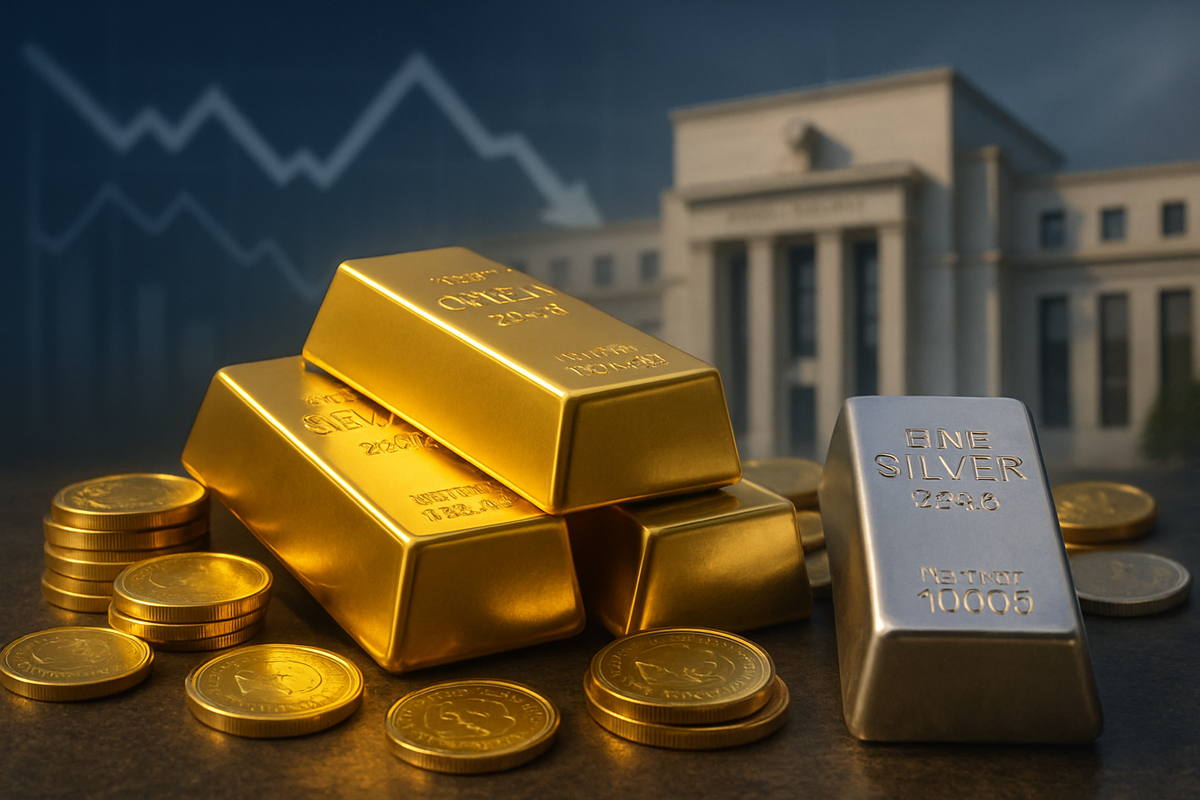
The financial markets are currently witnessing an extraordinary surge in the prices of gold and silver, propelled by a significant dovish pivot from the Federal Reserve. As of October 20, 2025, this shift in monetary policy, characterized by recent interest rate cuts and strong signals of further easing, has diminished the appeal of traditional yield-bearing assets and channeled investor capital into precious metals, driving them to unprecedented highs. This rally is not merely a fleeting speculative event but rather a structural re-pricing, reflecting deeper concerns about economic stability, inflation, and geopolitical uncertainties.
The Federal Reserve's Accommodative Turn and Its Market Repercussions
The Federal Reserve has unequivocally embraced an accommodative monetary policy, a stark contrast to the tightening cycles of previous years. The most concrete action was a 25-basis-point interest rate cut implemented in September 2025, bringing the federal funds rate to a target range of 4.00%-4.25%. This marked the first such reduction in nine months, and market participants are now widely anticipating another 25-basis-point cut at the upcoming Federal Open Market Committee (FOMC) meeting on October 28-29, with some forecasts showing a 97-99% probability. Further easing is expected throughout the remainder of 2025 and into 2026, with projections indicating the federal funds rate could settle around 3.50%-3.75% by year-end 2025 and approach 3% in 2026.
This dovish pivot is primarily driven by a softening labor market, as highlighted by Federal Reserve Chair Jerome Powell on October 14, 2025, who noted that a sharp slowdown in hiring poses a significant risk to economic stability. While core Personal Consumption Expenditures (PCE) inflation remains slightly above the 2% target, the Fed appears to be prioritizing support for economic activity. Key players like Governor Christopher Waller and newly appointed Fed Governor Stephen Miran have publicly supported these cuts, with Miran even dissenting at the September meeting to advocate for a larger, 50-basis-point cut. Powell also hinted on October 15, 2025, at an earlier conclusion to the central bank's quantitative tightening (QT) policy, reinforcing the dovish posture and suggesting more liquidity for the financial system.
The immediate market reactions extend beyond precious metals. Equity markets, particularly growth sectors, have generally responded positively, with the S&P 500 Index rising 3.6% in September and reaching new all-time highs. However, some analysts caution about potential volatility if rate cuts are perceived as a response to a deeper economic decline. Treasury yields have shown mixed reactions, with some dipping to multi-month lows while others moved higher as the market priced in future cuts. The U.S. Dollar has generally weakened against major peers, making dollar-denominated commodities more attractive. The housing sector has also shown signs of optimism, with the October NAHB housing market index rising to a 6-month high, spurred by cheaper capital.
Companies Riding the Wave and Those Facing Headwinds
The Federal Reserve's dovish stance and the subsequent rally in gold and silver have created a clear dichotomy in the financial markets, presenting significant opportunities for some companies while posing considerable challenges for others.
Winners from the Rally:
The most direct beneficiaries are gold and silver mining companies, along with precious metals streaming and royalty firms. Higher metal prices directly translate to increased revenues and expanded profit margins, assuming stable production costs. This enhanced profitability can lead to greater capital for exploration, stronger balance sheets, and improved shareholder returns.
- Gold Mining Companies: Leading the charge are giants like Barrick Gold Corporation (NYSE: GOLD) and Newmont Corporation (NYSE: NEM), the world's largest gold miner, both poised for significantly improved margins and enhanced cash flow. Kinross Gold Corporation (NYSE: KGC) and Agnico Eagle Mines Limited (NYSE: AEM) are also seeing their valuations soar.
- Silver Mining Companies: Fresnillo Plc (LSE: FRES / OTCPK:FNLPF), the world's largest primary silver producer, reported a staggering 297% increase in profit for the first half of 2025. Other key players like First Majestic Silver Corp. (NYSE: AG), Pan American Silver Corp. (NASDAQ: PAAS), and Hecla Mining Company (NYSE: HL) are experiencing robust gains.
- Precious Metals Streaming and Royalty Companies: Firms such as Wheaton Precious Metals Corp. (NYSE: WPM) and Sandstorm Gold Ltd. (NYSE: SAND) provide upfront payments to miners in exchange for future production at fixed, low prices. A surge in spot prices directly boosts the value of the metals they are entitled to, significantly enhancing revenue without the operational risks of mining.
- Financial Institutions with Gold Exposure: Gold-centric Non-Banking Financial Companies (NBFCs) in India, like Muthoot Finance and Manappuram Finance, are seeing impressive gains as rising gold prices boost the value of their collateral. Precious metals ETFs like SPDR Gold Shares (NYSEARCA: GLD) and iShares Silver Trust (NYSEARCA: SLV) provide investors with direct exposure to the rally.
Losers from the Rally:
Conversely, companies that rely on gold and silver as raw materials face increased input costs, which can squeeze profit margins or necessitate price increases that dampen consumer demand.
- Jewelry Retailers and Manufacturers: Brands such as Mejuri, Melanie Auld, Jenny Bird, Signet, Pandora, and Tiffany & Co. are experiencing significant headwinds. While higher metal prices might boost inventory valuation, they often lead to reduced sales volumes as affordability declines. Consumers are increasingly opting for lighter pieces or postponing purchases.
- Electronics Manufacturers: Silver is a critical component in various electronic devices due to its superior conductivity. Industries heavily reliant on silver, particularly solar panel manufacturers like First Solar, Inc. (NASDAQ: FSLR), are seeing their production costs rise dramatically, with silver's share of costs estimated to have jumped from 5% in 2023 to 14% in 2025. Major tech companies with extensive manufacturing operations, like Apple (NASDAQ: AAPL), could also face increased operational expenses.
- Electric Vehicle (EV) Manufacturers: EVs use significantly more silver than traditional vehicles. Companies like Tesla (NASDAQ: TSLA) and General Motors (NYSE: GM) could see increased manufacturing costs, though their diversified product lines might buffer the impact.
Broader Significance and Historical Parallels
The Federal Reserve's dovish pivot and the subsequent precious metals rally are unfolding against a backdrop of complex global dynamics, carrying wide-ranging implications that extend far beyond immediate market movements. This event fits into broader industry trends, creates ripple effects, and draws parallels to significant historical precedents.
Broader Industry Trends: The dovish Fed has contributed to equity rallies, particularly in growth sectors, as lower interest rates make future earnings more valuable. However, the simultaneous rally in gold (a traditional inflation hedge) and expectations of rate cuts (which can be inflationary) highlight market skepticism about the Fed's ability to balance inflation control with economic stability. In bond markets, short-term Treasury yields are expected to fall, but long-term rates may remain stubbornly high due to persistent inflation and government deficit spending. The mining sector is experiencing an unprecedented surge in demand for equipment and investment, benefiting partners in the supply chain. Meanwhile, the technology and real estate sectors stand to gain from cheaper financing.
Ripple Effects on Competitors and Partners: Within the mining industry, increased competition for resources and talent is likely as higher prices incentivize more exploration. Industries reliant on precious metals, such as electronics and solar panel manufacturing, may accelerate innovation in material science to develop cheaper conductive alternatives, potentially leading to a long-term shift away from traditional precious metal usage in some applications. Financial institutions face a mixed outlook; while lending volumes might increase, prolonged low rates could pressure net interest margins.
Regulatory or Policy Implications: The current environment puts immense pressure on the Federal Reserve to carefully manage expectations and maintain credibility, especially given the market's mixed signals. Discussions are also gaining traction regarding potential U.S. government gold policy evolution, including direct market acquisition, driven by concerns over unsustainable debt dynamics. The resurgence of tariffs, particularly from the Trump administration, is identified as a significant factor contributing to inflationary pressures, complicating the Fed's ability to ease monetary policy without re-accelerating prices.
Historical Precedents and Comparisons: The present rally is frequently compared to the gold surge of the 1980s, which was also driven by political and economic turmoil. However, analysts suggest the current rally may be more sustainable due to fundamental shifts like unprecedented institutional demand and the ongoing "de-dollarization" trend among central banks. A notable rally in precious metals also followed the 2008 financial crisis, underscoring their role as stores of value during periods of profound economic upheaval. Gold's performance in 2025 is on track for its biggest weekly gain since the pandemic-driven rally of 2020. Silver's breaking of its 1980 all-time record further highlights the extraordinary nature of the current rally.
What Comes Next: Navigating the Precious Metals Landscape
The Federal Reserve's dovish stance, characterized by a series of interest rate cuts and an anticipated conclusion to quantitative tightening, is expected to continue shaping the trajectory of gold and silver prices. As of October 20, 2025, this environment, coupled with persistent geopolitical uncertainties, inflation concerns, and robust industrial demand for silver, sets the stage for both short-term volatility and significant long-term growth potential for these assets.
Short-Term and Long-Term Possibilities: In the short term (next 6-12 months), the Fed is likely to implement further rate cuts, potentially bringing the federal funds rate to 3.50%-3.75% by year-end 2025. This, along with the expected end of QT, will continue to support gold and silver. Gold is projected to target $4,400-$4,500 per ounce by year-end 2025, while silver eyes $60-$75 per ounce. Long-term (beyond 2026), gold could potentially reach $6,500 by 2027 and $10,000 by 2030, with silver potentially exceeding $100 per ounce by 2035, driven by persistent inflation, currency weakness, and sustained demand.
Strategic Pivots and Adaptations: Investors should consider precious metals as a core component for portfolio diversification and as a hedge against inflation and geopolitical risks. Given the rapid gains, short-term volatility and corrections are highly probable due to overbought conditions and profit-taking. These pullbacks could be viewed as buying opportunities. For policymakers, the Fed will need to remain nimble, balancing inflation control with economic growth support. Mining companies may strategically increase exploration budgets to capitalize on elevated prices.
Market Opportunities and Challenges: Opportunities include the enhanced safe-haven appeal of precious metals amidst global uncertainties and their continued role as an inflation hedge. Silver's industrial boom, particularly from clean energy and technology sectors, provides a significant and growing demand floor. Challenges include inherent price volatility, the potential for a Fed reversal if inflation spirals, a stronger-than-anticipated rebound in the US Dollar, or a de-escalation of geopolitical tensions. For silver, the emergence of technological substitutes could also pose a long-term challenge.
Potential Scenarios: The base case is a continued bull market, where persistent geopolitical tensions, economic uncertainty, elevated inflation, and the Fed's dovish easing drive gold and silver higher. A short-term correction followed by a rally resumption is also a strong possibility, where profit-taking leads to a temporary dip before underlying fundamentals push prices higher again. A significant reversal (lower probability) could occur if there's a swift improvement in global stability, a definitive resolution of major conflicts, or a surprisingly hawkish pivot by the Federal Reserve.
Comprehensive Wrap-up for Market Participants
The current rally in gold and silver, ignited by the Federal Reserve's dovish stance, signifies a pivotal moment in financial markets. This is not merely a cyclical upturn but rather a structural bull market, reflecting a profound re-evaluation of trust in global finance and ongoing shifts in investment paradigms.
Key Takeaways: The Fed's commitment to lower interest rates, coupled with the anticipated end of quantitative tightening, is creating an environment highly conducive to precious metals. Gold has breached $4,000 per ounce, and silver has surpassed its 1980 all-time high, driven by reduced opportunity costs, a weakening dollar, robust safe-haven demand amidst geopolitical risks, persistent inflation concerns, and unprecedented central bank accumulation. For silver, strong industrial demand, particularly from green technologies, and structural supply deficits are additional powerful tailwinds.
Market Moving Forward: The outlook for gold and silver remains largely bullish for the foreseeable future. Major financial institutions are significantly raising their price targets, with gold potentially reaching $5,000 by early 2026 and silver possibly hitting $60-$75 per ounce by year-end. While short-term volatility and corrections are expected, they are likely to be healthy consolidations offering new entry points, rather than trend reversals. The ongoing de-dollarization trend and the persistent need for inflation hedges are expected to provide a strong fundamental floor for these assets.
Significance and Lasting Impact: This rally underscores the enduring role of gold and silver as stores of value, risk hedges, and portfolio diversifiers in an era of heightened global uncertainty. The sustained demand from central banks and institutional investors suggests a fundamental, lasting shift in how these assets are integrated into long-term financial planning. For silver, the confluence of expanding industrial applications and undeniable supply constraints suggests a permanent re-evaluation of its fundamental value, positioning it for continued dramatic growth.
What Investors Should Watch For: In the coming months, investors should closely monitor Federal Reserve communications, including statements from Chair Jerome Powell and FOMC minutes, for any shifts in policy trajectory. Key inflation indicators (CPI, core inflation) and US economic data, particularly labor market reports, will be crucial. The performance of the US Dollar Index (DXY) will continue to be a significant inverse correlator for precious metals prices. Geopolitical developments, especially US-China trade relations, should also be on the radar. Finally, be prepared for continued price volatility, viewing any significant pullbacks as potential strategic buying opportunities for long-term positions. The interplay of these factors will dictate the pace and magnitude of the ongoing precious metals bull run.
This content is intended for informational purposes only and is not financial advice



